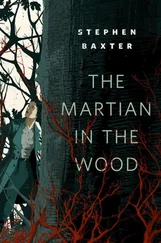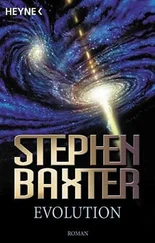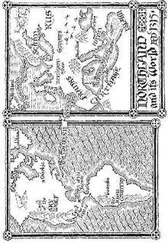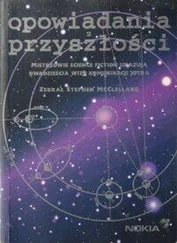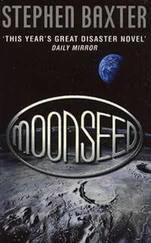And there was something alongside the star. It looked like netting — scoop shaped, like a catcher’s mitt, facing the star as if endeavoring to grasp it.
Obviously artificial.
Cassiopeia spoke. OUR JOURNEY IS NOT YET DONE, MALENFANT. WE MUST PENETRATE THE GALACTIC CENTER ITSELF. THIS IS WHAT WE WILL SEEK.
“This is the site of a gamma-ray burster,” Malenfant said. “A future reboot event. I’m right, aren’t I, Cassiopeia?”
THE STAR’S COMPANION IS AS YET SOME DISTANCE AWAY — BILLIONS OF KILOMETERS, IN FACT, TOO REMOTE TO SEE. AND YET THE CONVERGENCE HAS BEGUN. THE COLLISION IS INEVITABLE. UNLESS—
“Unless somebody does something about it,” Madeleine whispered.
That strange artifact continued to ride higher in the sky, like a filmy, complex moon. It was a net, cast across the stars. It must have been thousands of kilometers wide.
Madeleine found it impossible to believe it wasn’t a few meters above her head, almost close enough for her to just reach out and touch. The human mind was just not programmed to see giant planet-spanning artifacts in the sky. Think of an aurora, she told herself, those curtains of light, rippling far above the air you breathe. And now imagine that: It would hang there far beyond any aurora, suspended in space, perhaps beyond the Moon…
But there was something wrong: the netting was obviously unfinished, and great holes had been rent into its structure.
“It’s broken,” Malenfant said.
YOU WOULD CALL THIS A SHKADOV SAIL, the Gaijin said.
It would be a thing of matter and energy, of lacy rigging and magnetic fields: a screen to reflect the neutron star’s radiation and solar wind. But it was bound to the star by invisible ropes of gravity.
“Ah,” Madeleine said. “You disturb the symmetry of the solar wind. You see, Malenfant? The wind from the star will push at the sail. But the sail isn’t going anywhere, relative to the star, because of gravity. So the wind gets turned back…”
“It’s a stellar rocket,” Malenfant said. “Using the solar wind to push aside the star.”
THAT IS THE PURPOSE. WHEN COMPLETE IT WILL BE A DISC A HUNDRED THOUSAND KILOMETERS ACROSS, ALL OF IT LACED WITH INTELLIGENCE, A DYNAMIC THING, CAPABLE OF SHAPING THE STAR’S SOLAR WIND, RESPONDING TO ITS COMPLEX CURRENTS.
Malenfant grinned. “Hot damn. Somebody is fighting back.”
“Who is building this thing? You?” Madeleine asked.
NOT US ALONE. MANY RACES HAVE COME HERE, COOPERATED ON THE SAIL’S CONSTRUCTION. IT APPEARS TO HAVE BEEN A RELIC FROM A PREVIOUS CYCLE, FROM BEFORE A PREVIOUS REBOOT.
“Like the Saddle Point network.”
Madeleine peered doubtfully at the huge, unlikely structure. “How can a sail like that move a neutron star — an object more massive than the Sun?”
THE THRUST IS VERY SMALL, THE ACCELERATION MINUSCULE. BUT OVER LONG ENOUGH PERIODS, SMALL THRUSTS ARE SUFFICIENT TO MOVE WORLDS. EVEN STARS.
“And will that be enough to stop the coalescence of this binary, to stop the reboot?” Madeleine asked.
NOT TO STOP IT. TO POSTPONE IT GREATLY, BY ORDERS OF MAGNITUDE. IF WE CAN DELAY THIS STERILIZATION EVENT—
“We might win time,” Malenfant said.
Madeleine challenged the Gaijin. “Is this really the best option? Haven’t you come up with anything smarter?”
Malenfant eyed her. “Like what?”
“Hell, I don’t know. You could use antigravity. Einstein’s cosmological constant, the force that makes the universe expand. Or you could interfere with the fundamental constants of physics. For example there is a particle called the Higgs boson, which gives matter its mass. If you took it away, switched it off, you could make your neutron stars lighter, and then just push them aside. In fact, take all the mass away and they would fly off at the speed of light. Easy. Give me a lever and I will move the world…”
WE HAVE NO SUCH POWERS, Cassiopeia said, and Madeleine thought she detected sadness in that synthesized voice. WE HAVE SEARCHED. THERE IS NO CIVILIZATION SIGNIFICANTLY MORE ADVANCED THAN OUR OWN — EVEN BEYOND THE GALAXY.
IT IS LIKE YOUR FERMI PARADOX. IF THEY EXISTED, WE WOULD SEE THEM. IMAGINE A GALAXY WITH ALL THE STARS FARMED, COVERED BY DYSON SPHERES, THEIR PHYSICS ALTERED PERHAPS TO EXTEND THEIR LIFETIMES. IMAGINE THE GALAXY ITSELF ENCLOSED BY A DYSON STRUCTURE. AND SO ON. EVEN SUCH CLUMSY ENGINEERING, ON SUCH A SCALE, WOULD BE VISIBLE. WE SEE NO SUCH THING, AS FAR OUT AS WE LOOK, AS DEEP INTO SPACE AND TIME.
But it wasn’t a surprise, Madeleine thought. How long would it take a galactic civilization to rise — even supposing somebody could survive the wars and assorted despoliation? Because of light speed, it would take a hundred thousand years for a message to cross the Galaxy just once. How many such exchanges would it take to homogenize the shared culture of a thousand species, born of different stars and biochemistries, creatures of flesh and metal, of rock and gas? A thousand Galaxy crossings, minimum?
But that would take a hundred million years, and by that time the next burster would have blown its top, the next reboot driven everybody back to pond scum.
So maybe this clumsy net really was the best anybody could do. But still, good intentions weren’t enough.
“Tens of millions of years,” she said. “You’d have to maintain that damn thing for tens of millions of years, to make a difference. How can any species remotely like us, or even you, maintain a consistency of purpose across megayears? None of us even existed in anything like our present forms so long ago.”
BUT, Cassiopeia said slowly, WE MUST TRY.
“We?” Malenfant said.
YOU MUST JOIN US, MALENFANT.
Madeleine clutched at Malenfant’s hand. But he pushed her away. She looked up at him. His face was pinched, his eyes narrow. He was starting to feel scared, she realized, drawn out, as if pulled into space by the thing in the sky, up toward the zenith.
Because, she realized, this is his destiny.
Malenfant stood before the alien robot, silhouetted against Galaxy core light. He looked helplessly weak, Madeleine thought, a ragamuffin, before this representative of a cool, immeasurably ancient galactic power.
Yet it was Cassiopeia who was supplicating before Malenfant, the human.
“You can’t do it,” he said, wondering. “You can’t complete this project. There is something… missing in you.”
THERE IS CONTROVERSY, Cassiopeia said.
Madeleine glared up at that filmy structure. There were holes in the netting you could have passed a small planet through, places where thousand-kilometer threads seemed to have been burned or melted or distorted. Controversy.
“Wars have been fought here,” Malenfant said bluntly.
THE RACES OF THE GALAXY ARE VERY DIVERGENT. UNITY DISSOLVES. THERE IS FREQUENT CONFLICT. SOMETIMES A RACE WILL SEEK TO TAKE THIS TECHNOLOGY AND USE IT FOR ITS OWN PURPOSES; THE OTHERS MUST MOUNT A COALITION TO STOP THE ROGUE. SOMETIMES A RACE WILL SIMPLY ATTEMPT TO IMPOSE ITS WILL ON OTHERS. THAT USUALLY ENDS IN CONFLICT, AND THE EXPULSION OR EXTERMINATION OF THE AMBITIOUS.
Malenfant laughed. “Infighting. Sounds like every construction project I ever worked on.”
THERE ARE DIVERGENCES AMONG US.
Madeleine looked up, startled. “You mean, even among the Gaijin?”
THERE ARE FACTIONS WHO WOULD ARGUE THAT WE SHOULD ABANDON THE PROJECT TO OTHER RACES, CALCULATING—
Malenfant grunted. “Calculating that the others will finish the job for you — without you incurring the costs of the work. Gambling on the altruism of others, while acting selfishly. Games theory.”
OTHERS SEEK A TIME SYMMETRY…
Malenfant seemed baffled by that, but Madeleine thought she understood. “Like the Moon flowers, Malenfant. Do you know of them? If the Gaijin could train themselves to think backward in time, then they needn’t face this… terminus… in the future.”
Читать дальше
Конец ознакомительного отрывка
Купить книгу

